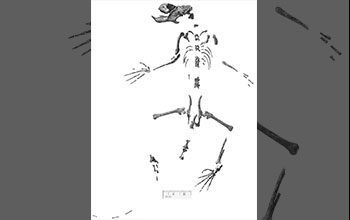Multimedia Gallery
Reconstructed skeleton of early primate Carpolestes simpsoni
A reconstructed skeleton of Carpolestes simpsoni, an early primate from the Paleocene era. The almost-complete skeleton--the only one known to exist--was recovered from a 56 million-year-old limestone nodule that was found in the state of Wyoming. Study of the skeleton indicates that the animal had grasping hands and feet which allowed it to forage for flowers, fruit, seeds and insects on slender branches of trees and shrubs. Some of its features are strikingly similar to those of modern primates and may indicate that they share a recent common ancestor.
This illustration was created for an article that appeared in the Nov. 22, 2002, issue of Science magazine about the outcome of a grant investigating plesiadapiform functional morphology and relationships to primates of modern aspect. The principal investigators of National Science Foundation-supported grant BCS 01-29601 are Phil Gingerich and Greg Gunnell of the University of Michigan. (Year of image: 2002)
Credit: Doug M. Boyer
Special Restrictions: Permission must be obtained from the artist before using this image. Interested parties should contact dboyer@ic.sunysb.edu and carpo@umich.edu.
Images and other media in the National Science Foundation Multimedia Gallery are available for use in print and electronic material by NSF employees, members of the media, university staff, teachers and the general public. All media in the gallery are intended for personal, educational and nonprofit/non-commercial use only.
Images credited to the National Science Foundation, a federal agency, are in the public domain. The images were created by employees of the United States Government as part of their official duties or prepared by contractors as "works for hire" for NSF. You may freely use NSF-credited images and, at your discretion, credit NSF with a "Courtesy: National Science Foundation" notation.
Additional information about general usage can be found in Conditions.
Also Available:
Download the high-resolution JPG version of the image. (246.4 KB)
Use your mouse to right-click (Mac users may need to Ctrl-click) the link above and choose the option that will save the file or target to your computer.

